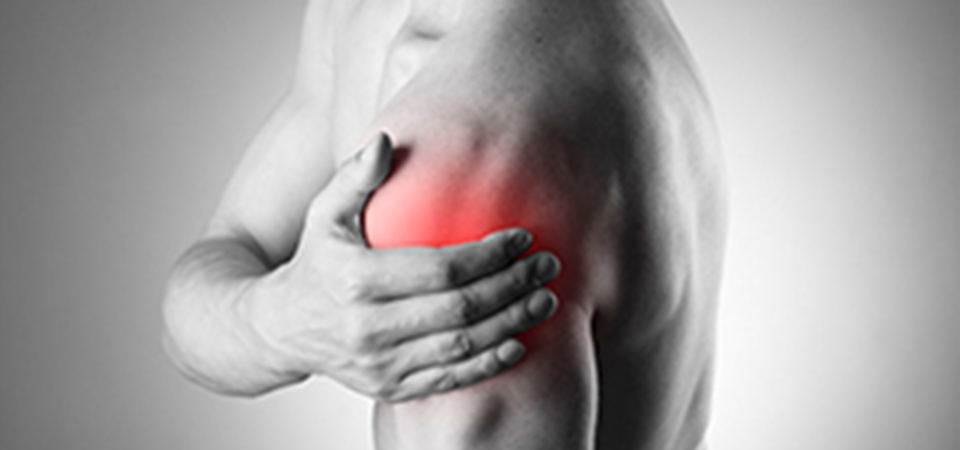
One of the most common compensations we see with people with limited overhead shoulder elevation is lateral winging of the scapula. Anytime you have limited glenohumeral joint mobility, your scapulothoracic joint is going to try to pick up the slack to raise your arm overhead.
This is common in postoperative patients, but also anyone with limited shoulder elevation.
Stabilizing the scapula during range of motion is often recommended to focus your mobility more on the shoulder than the scapula. As with everything else, as simple as this seems, there is right way, a wrong way, and a better way to stabilize the scapula during shoulder elevation.
Your “scapulohumeral rhythm” is the pattern of muscle contractions and motion that occurs between your scapula and your humerus (upper arm bone).
When your scapulohumeral rhythm becomes abnormal -due to pain, weakness or muscle inco-ordination – you are rendered more likely to suffer shoulder clicking, pain or rotator cuff injury.
Poor scapula stability usually results in tipping and downward rotation of your scapula, which causes your shoulder tip (acromion) to pinch down into the subacromial structures (eg bursa and rotator cuff tendons) causing rotator cuff impingement, shoulder bursitis or rotator cuff tears.
Normal shoulder blade-shoulder movement – (scapulo-humeral rhythm) – is required for a pain-free and powerful shoulder function. Abnormal scapulohumeral rhythm can be retrained by an experienced shoulder physiotherapist.
When we perform flexion, the glenohumeral (GH) joint contributes 100°-120°. The scapula on the thorax contributes to elevation (flexion and abduction) of the humerus by upwardly rotating the glenoid fossa 50° to 60° from its resting position. If the humerus were fixed to the fossa, this alone would result in up to 60° of elevation of the humerus. The humerus, of course, is not fixed but can move independently on the glenoid fossa.
Inman et al. reported an inconsistent amount and type of scapular motion in relation to GH-motion during the initial 60°. In this early phase (0-60°), motion occurs primarily at the GH joint, although stressing the arm may increase the scapular contribution. During abduction of the humerus in the plane of the scapula, an average of 43° of lateral rotation from the resting position has been reported, with peak lateral rotation generally occurring between 90° and 120° of humeral elevation. It must also be recognized, however, that elevation of the arm is often accompanied not only by elevation of the humerus but also by lateral rotation of the humerus in relation to the scapula.
When we perform abduction, the GH-joint contributes 90-120°. The combination of scapular and humeral movement result in a maximum range of elevation of 150-180°. Also by abduction Inman et al. reported an inconsistent amount and type of scapular motion in relation to GH-motion this time during the initial 30°. In this early phase, motion occurs primarily at the GH joint, although stressing the arm may increase the scapular contribution.
Scapulohumeral Ratio
Scapulohumeral rhythm or ratio is significantly greater (less scapular motion and more humeral motion) in the sagittal plane than other planes. Consistent with the findings, the dominant side demonstrated significantly higher values for SH rhythm than the non-dominant side but only in the coronal and scapular planes but not in the sagittal plane. By healthy male is a significant difference by hand dominance only in scapular upward rotation during scapular plane arm elevation.
The scapulohumeral rhythm is therefore defined as the ratio of the glenohumeral movement to the scapulothoracic movement during arm elevation. This is most often calculated by dividing the total amount of shoulder elevation (humerothoracic) by the scapular upward rotation (scapulothoracic).

Your physical therapist is an expert in the assessment and correction of your scapulohumeral rhythm. Any deficiencies will be an important component of your rehabilitation.
Researchers have identified poor scapulohumeral rhythm as a major cause of rotator cuff impingement. Plus, they have identified scapular stabilisation exercises one of the key ingredients for successful shoulder rehabilitation.
Both passive and active movement disturbances can cause a scapulohumeral rhythm dysfunction. Causes may be: shortening of muscles like m. Pectoralis Minor, m. Latissimus Dorsi and m. Levator Scapulae, shortening of the posterior joint capsule and/or lack of coordination between essential muscles like the m. Serratus Anterior, m. Trapezius and Rotator Cuff muscles
It may be clear that every therapy should be individualized.
Shortening of muscles or connective tissue must be done by stretching and/or active and passive mobilizations. It’s important that the patient gets a home exercise program to continue stretching and mobilizations . Middle thoracic manipulations in seated position have no influence on the scapulohumeral rhythm and scapular kinematics during arm flexion and thus should be avoided.
Training the coordination between muscles should be done in two phases. Phase one will include the ‘setting’ of the muscles. In this phase the patient will learn how to subtle contract his muscles. Tactile feedback or myofeedback may be necessary during this phase. Practicing at home is important to train the duration of muscle contraction and train in other positions so that contraction is possible in every posture of daily life. In phase two the contraction should be automated. This can be trained with stabilization exercises. Exercises on the back should be avoided because muscles should stabilize the scapula instead of the ground. The stabilization exercises should be static and dynamic . Examples of exercises are: shirley sahrmann wall slides, push up plus, press-up, low-rowing, horizontal abduction, serratus punch and dynamic hug .
Muscles should be trained in functional patterns (sport or activity specific patterns) instead of isolated patterns because it will cause maximal scapular muscle activations .
Please ask your physical therapist for more information regarding scapulohumeral rhythm assessment and corrective treatment or exercises.